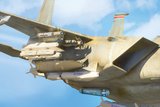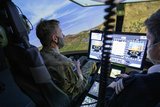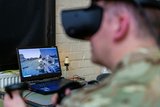Controlling the Skies - Air Dominance Solutions for the Asia Pacific (Studio)
As US allies in the Asia-Pacific region grapple with growing regional threats, air dominance has rapidly expanded as a priority. Raytheon Intelligence & Space (RI&S) has deepened its focus on the market in recent years, enhancing its offerings in everything from radar to electronic warfare (EW).
RI&S’ work in the Asia-Pacific air dominance market builds on longstanding relationships.
For example, many of the company’s technologies are in service in Japan, such as the AN/APG-63 radar system, which is used on the country’s F-15 fighter aircraft; discussions are currently underway to upgrade these to the more modern APG-82 AESA radar system baseline, with Raytheon Technologies working closely with aircraft manufacturer Boeing on the platform.
‘We have a significant amount of work in Japan and work with our customer on a daily basis to ensure that their needs are met, from sustainment to future aircraft,’ said Michelle Styczynski, vice president, F-15 programmes at RI&S.
Japan’s air dominance needs have intensified in recent years. Tokyo has prioritised the development of the F-X, a sixth-generation indigenous fighter aircraft.
It is expected that Japanese industry will look to partner with international contractors for this aircraft, said Styczynski.
While such advanced aircraft are essential, air dominance must now be achieved against the backdrop of multi-domain operations, with land, sea, air, space and cyber increasingly intertwined.
Japan’s National Defence Program Guidelines for 2019 make clear that space, cyber and electronic warfare are vital priorities for the country’s armed forces, areas that have also become core focuses for RI&S over the past decade, Styczynski noted.
Such technologies – and the aircraft they empower and protect – have evolved in many ways over the past decade, with capability enhancements helping operators adapt to new threats.
Over the past decade, ‘there’s been a continued need to support aircraft modernisation as well as sustainment needs, while developing next gen technologies for our partners’, said Styczynski.
RI&S specialises in open architecture systems that allow for rapid upgrades and scalability, across products like radars, such as the APG-82; EW systems such as the Next Generation Jammer Mid-Band (NGJ-MB) and the Dual-Band Decoy for the US Navy’s F/A-18 E/F; and electro-optical/infrared technologies like the Multi-Spectral Targeting System.
System and platform-agnostic support is increasingly crucial for such systems, Styczynski stressed, though this also demands a heightened focus on cybersecurity.
‘That’s going to be at the forefront, with the threats that are upcoming,’ she explained.
RI&S’ work in Japan is part of its broader activity in Asia-Pacific. The company has provided countries in the region with systems from the NGJ-MB to fire control radars, Styczynski said. Major markets include the Republic of Korea, Australia and Singapore.
‘In that region, we leverage the capabilities, scalability and power of overall RI&S defence and security requirements,’ Styczynski added.
While air dominance technologies are evolving, so are the ways in which those technologies are developed. This is particularly notable when it comes to digital engineering.
Through the use of concepts like “digital twins”, the entire design process and overall programme lifecycle can be driven much more quickly. Such technology is now a significant focus for RI&S, said Styczynski.
‘It’s about having all of your systems integrated, from initial design to supply chain to operations build, to get capability quicker. We have already started incorporating that into a lot of our programmes,’ she explained, noting that such technologies could ‘definitely be applied to the F-X future fighter, from womb to tomb’.
Digital engineering aims to assist the build cycle, producing capabilities much more quickly. This is a core capability for RI&S. A primary focus in terms of its leadership priorities, Styczynski said, is ‘to incorporate that into our current programmes and reap the benefits’.
One example in the air dominance field is the company’s Common Open Secure Mission Computer (COSMC), a platform-agnostic system that can be used on any aircraft, whether fixed- or rotary-wing. The company won a deal in late 2020 to supply COSMC to the US Special Operations Command.
By using a DevSecOps, iterative approach to software development on COSMC, where software is continuously improved through a customer/operator interface throughout its lifecycle, ‘users can field the system much more rapidly than you would a system that was created five to 10 years ago’, Styczynski explained.
‘It also ensures that users are not stuck in the legacy, on/off development cycle that we have seen in the past … there’ll be continual development, continual integration and continual maturation of this architecture, to be able to offer these things that are already essentially readymade.’
Styczynski expects to see substantial developments in open architecture systems in the coming years, which will make it much easier to build and upgrade air dominance technologies.
The company already sees this evolution occurring in its radar products, such as the APG-82. RI&S has supported Japan with the APG-63 for decades, and will continue to do so into the future, while the APG-82 will bring the country a range of new capabilities to address the threats in Japan’s region.
RI&S expects to reach several milestones in the broader air dominance market in the short and medium-term, Styczynski said, such as the delivery of the first AN/APG-79(v)4 AESA radar system to the US Marine Corps later this month, followed by subsequent flight tests.
The company also expects to continue flight tests with the NGJ-MB, she added, while its APG-82 was part of the first flight of the Boeing F-15EX in February 2021.
‘The team did an incredible job of getting those radars out very quickly to Boeing to support these needs,’ she said. ‘It’s going to be interesting to be a part of the F-15EX domestic market, but there’s also an F-15EX international market that is going to be really exciting.’
More from Studio
-
![Combat-proven capabilities: How precision-strike systems are evolving for tomorrow’s battlespace (podcast)]()
Combat-proven capabilities: How precision-strike systems are evolving for tomorrow’s battlespace (podcast)
Combat-tested technology is being reshaped to counter A2/AD threats, reduce reliance on GPS and enable faster, more autonomous targeting in complex environments. In this special podcast, experts explain how the evolving threat landscape is shaping next-generation strike capabilities.
-
![Energy evolution: How laser defence systems are powering the next phase of air defence (podcast)]()
Energy evolution: How laser defence systems are powering the next phase of air defence (podcast)
Laser-based air defence is moving from promise to deployment as global threats evolve. In this special podcast, we explore how high-energy laser systems are reshaping interception strategies.
-
![Intelligence advantage: How real-time GEOINT is reshaping military decision-making (Studio)]()
Intelligence advantage: How real-time GEOINT is reshaping military decision-making (Studio)
In today’s contested operational environment, adaptability is key. The new Geospatial-Intelligence as a Service (GEO IaaS) solution from Fujitsu and MAIAR empowers militaries by enabling intelligence advantage, combining advanced technology with human expertise to deliver actionable insights.
-
![Training Together: Unlocking Educational Excellence through Military and Industry Collaboration (Studio)]()
Training Together: Unlocking Educational Excellence through Military and Industry Collaboration (Studio)
Military training is ultimately about people. At Capita, training programmes are built on close engagement with partners, delivering an educational approach that can adapt to individual needs, cultivate leadership – and drive wider cultural change.
-
![Enhancing Military Training Through Digital Technology (Studio)]()
Enhancing Military Training Through Digital Technology (Studio)
Digital technologies offer huge opportunities for defence training. However, militaries must adopt an agile approach, placing the needs of their organisations and personnel at the centre of their efforts.
-
![Layered Defence: How new technologies are enhancing armoured vehicle survivability and manoeuvrability (Studio)]()
Layered Defence: How new technologies are enhancing armoured vehicle survivability and manoeuvrability (Studio)
As modern threats evolve, armoured fighting vehicles face a new era of challenges, from loitering munitions to kinetic energy projectiles. Advances in active, passive, and reactive protection systems are crucial to ensuring battlefield dominance, freedom of manouver and vehicle survivability.






















